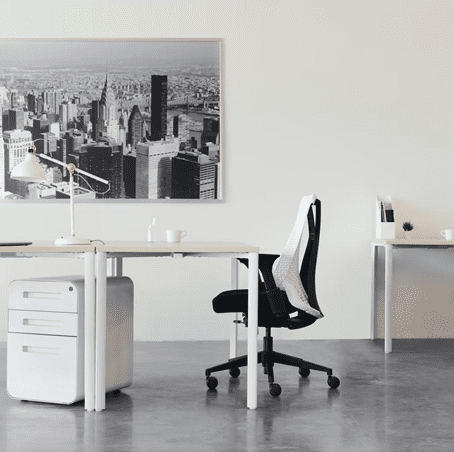
Desk Ergonomics: Avoid Hurting Yourself While You Work

Desk Ergonomics: Avoid Hurting Yourself While You Work
Guest Blog by Stephanie Haywood of My Life Boost
Modern-day office workers typically sit for hours at their desk all day, every day, for years on end –something the human body wasn’t designed to do. Unless they practice good desk ergonomics, backed up by good work habits, they can and do develop debilitating health problems. As the CDC can confirm, these can range from not-so-severe spasms and aches to serious conditions like chronic pain and musculoskeletal disorders (MSDs).
Is there a solution? You can’t exactly stop working, after all. The answer may lie in the design of your desk, among other related things. Fixated Insurance offers solutions to protect your business – ranging from workplace insurance products and services to helpful advice on maintaining your health as you work. In this article, we take a look at how you can safeguard your health by understanding and integrating desk ergonomics:
What are desk ergonomics?
Desk ergonomics, also known as office ergonomics, is the process of designing and arranging workplaces, tools, and furniture to cater to the wellbeing of workers. It aims to reduce or eliminate physical stress and resulting injuries related to constant sitting and poor posture.
Should you bother with desk ergonomics?
Even if you’re fit and don’t have problems at the moment, desk ergonomics, just like insurance, can be a worthwhile investment. It’ll support your continued health and wellbeing as you age, minimize eye strain and physical stress, and generally keep you more productive and focused long-term.
Desk Ergonomic Essentials
Ergonomics is still being developed. Consequently, best practices and methodologies vary and aren’t precise. However, they all focus on the following:
● Posture: Good posture keeps your spine healthy and minimizes stress in your joints. The best way to sit at your desk is erect. The monitor should be slightly below eye level, and your wrists and hands should be supported as you type.
● Eye-health: Fixedly staring at your screen all day causes eye strain. The glare (maybe radiation) from your screen can make matters worse. Good ergonomic best practices – like the 20/20/20 rule – can keep your eyes healthy.
● Breaks: People are advised to work in short, frequent bursts instead of continuously. Work schedules incorporate micro-breaks, like minute-long pauses between heavy-duty typing, and rest breaks for a few minutes every hour or so.
● Movement: You should try to move every thirty minutes. Get up, do some stretching, practice desk yoga, and generally keep the blood and energy flowing through your body.
● Environment: Your environment is constantly interacting with your body. Make sure it’s a pleasant interaction. Some ways to make a better environment are to use quality furniture, maintain comfortable lighting, introduce indoor plants, and work at a moderate temperature.
Is it expensive to go ergonomic?
Ergonomics don’t necessarily have to be expensive. Ergonomic best practices – like taking breaks, moving around, and practicing eye exercises – are free. Moreover, you can find ergonomic furniture or tools at bargain prices. For example, it’s possible to get high-quality office chairs and other furniture offering lumbar support for under $200.
Ergonomic furniture suggestions
For the best results, it’s a good idea to get a full-fledged ergonomic setup. A single ergonomic item won’t do much unless it’s part of a greater, supportive whole. A complete workstation, according to the University of North Carolina, can include:
● Chairs: Chairs support your back and spine, prop you up, minimize body pain, and keep your feet at rest.
● Keyboards: High-quality keyboards stop your fingers from hurting if you type all day.
● Mice: When you click a lot, a good mouse can stop your fingers from hurting and ably support your wrists.
● Wrist rests: Wrist rests will prop up your arms and stop your hands from hurting.
● Monitors: High-quality monitors with anti-glare screens and/or support for high refresh rates will reduce eye glare.
● Desks: Adjustable or even standing desks at appropriate heights will prevent you from developing a bad posture.
● Lighting: Some kinds of specially-designed lighting reduce eye strain, fatigue, and headaches.
● Miscellaneous items: Other items worth considering are footrests, cushions, document holders, and headsets.
Conclusion
Paying attention to your desk ergonomics offers significant benefits – not only will they help you feel good all day, but studies show they can increase your productivity. If you work in an office setting, it’s a fact worth mentioning to your boss, it may convince them to change the office setup.
Image via Unsplash
Categories: Blog
